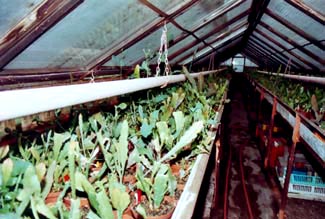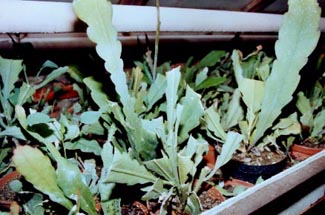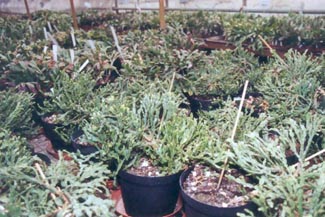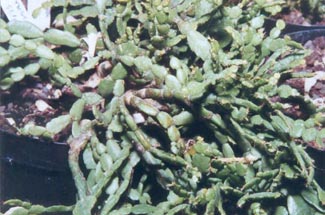****** IN KAKTEEN HAAGE GREENHOUSES ******
The mother plants greenhouses
(Page 4/4)
The greenhouses where the mother plants live are much smaller
and lower than the previous ones ; they are also older.

Epiphyllum mother plants greenhouses
I was very surprised when I saw the hybrid Epiphyllum mother plants. I expected enormous pots containing big plants. Instead of that, the mother plants were in pots which were only 15 to 20 cm in diameter. Moreover, the plants had been pruned many and many times.

hybrid Epiphyllum mother plants
So I wondered how it was possible to produce enough cuttings starting from "so small" plants.
Then, Ulrich told me that, contrary to the greenhouses which contained plants intended to be sold soon, the mother plants greenhouses were, during the whole winter, maintained completely dry and cold. Afterwards, in spring, as soon as temperatures were high enough , the first waterings were quickly and thouroughly made, this method allowing a sudden and abundant vegetative growth, with the forming of many additional stems which were cut and later planted to induce rooting.
I now remember having observed a very different technique at Rainbow Gardens in the United States. To quickly obtain many stems, Epiphyllum were grafted on big Opuntia ficus indica stocks and grown directly in the ground. But California's climate is not Germany's.
And to conclude these pages, let me show you some impressive
plants : they are Schlumbergera russelliana stools. They had particularly
unusual small stem-segments.


Schlumbergera russelliana mother plants
These pages only deal with epiphytic cacti, but I also saw a splendid collection of globular cacti, and a just as splendid collection of Lithops. But more pages would be necessary....
If, as I hope, you are interested in the purchase
of plants from Kakteen Haage, or just in consulting the catalogue, there's
the link in my links page.
BACK TO THE BEGINNING OF THE ARTICLE HOME PAGE
_____________________________________________________________________